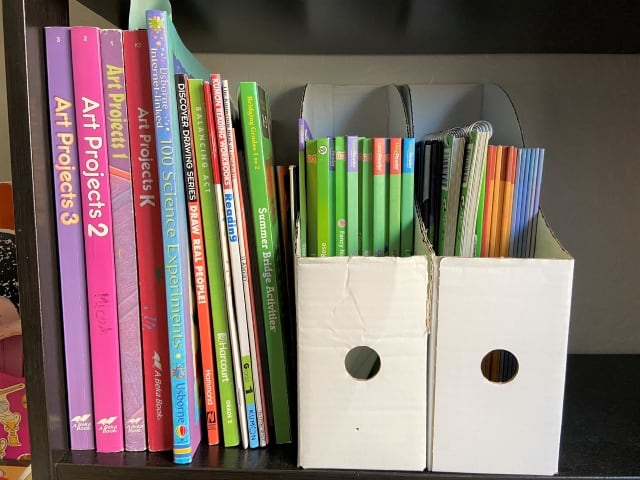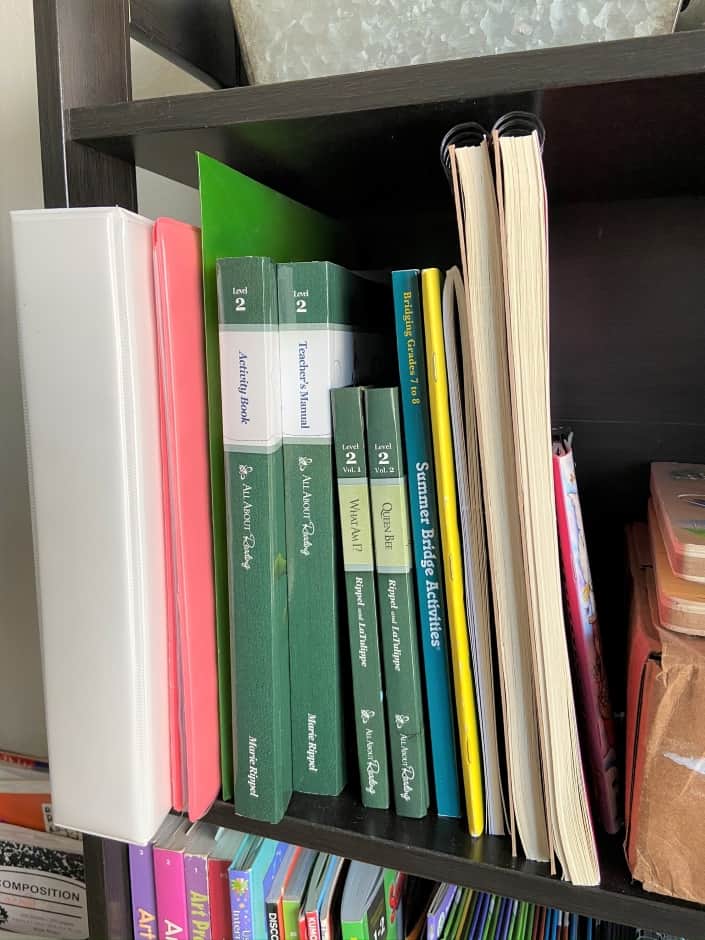How to choose homeschool curriculum for you and your family may seem a bit overwhelming. With so many options available, how do you know which one is the right one? Continue reading for some guidance on how to choose curriculum!

This is a series called Get Started With Homeschooling. I’ll be writing about everything you need to know when getting started with homeschooling. Having a vision for your homeschool, curriculum choices, tips and tricks, routines and organization, and thriving in your homeschool.
Click the links below to read the posts in this series:
Know your state’s homeschool laws.
Before you start picking out homeschool curriculum for your kiddos, you first need to find out what the homeschool laws are for your state. This may affect your curriculum choice.
- Are you required to take attendance?
- Are you required to submit testing or grades to the school district?
- Do you need a college education to teach your children?
One of the best resources for finding your state laws is provided on the HSLDA website.
On the HSLDA Legal page you can find detailed information on how to withdraw from public school, homeschooling requirements including testing & mandatory subjects, resources and more.
Once you know your state’s homeschooling laws you can start looking at curriculum!
How to choose homeschool curriculum
There are 3 main areas to consider when choosing curriculum:
- The Children
- Yourself
- Your Situation
Child’s Learning Style
Did you know there are several different learning styles? When I first started homeschooling I didn’t know about learning styles.
Knowing your child’s learning style can help in picking the best curriculum for them and you.
There are 4 main styles:
- Visual – learns best by seeing things and memorising information in a visual way.
- Auditory – learns best by hearing and listening.
- Reading/Writing – learns best by reading, taking notes, drawing a picture and writing essays
- Kinesthetic – learns best with hands-on activity, movement and touch
It may take some trial and error at first to find your child’s dominant learning style, but it’s worth the effort!
My daughter struggles in math and needs to see a visual example given in multiple ways when learning new math concepts, while my son can read the directions and understand without seeing a visual example.
Knowing this I am able to best teach two very different kids and they are able to learn new things without getting upset or frustrated.

Your Teaching Style
As the teacher you need to think about how you best like to teach your children. Would you like to sit or stand while teaching? Do you like to teach while walking or moving around? Do you need a quiet environment to teach or can you be outside at a park?
I have learned that I get bored with a textbook based or worksheet based curriculum. Teaching through great books and videos is my preference. I would rather teach them about a bear by visiting the zoo and looking and observing the actual animal we are studying!
Make sure that you not only consider your child’s learning style but also your teaching style when choosing curriculum.
One year I tried out a new curriculum that was workbook and worksheet based. I abandoned that curriculum after 2 months and bought a whole new curriculum!! That was a pricey lesson to learn!
You may also choose a curriculum that you do not enjoy teaching and have to pivot mid school year. Do not be afraid to make a curriculum change! It’s better to find what works for you and your kids than to press on with a curriculum you dislike.
Your Situation
This will be different for each family and can change from year to year. Items to think about are:
- Time
- Budget
- Space
Time
How much time do you have to dedicate to teaching your children? Will you need to seek outside help for certain subjects? Would you like to participate in a local homeschool co-op group?
The first priority is to make sure you are meeting your state’s homeschool subject requirements and branch out from those. Knowing your state’s laws will help keep you focused on what is important to teach but also give you freedom to say “No” when something does not align with those needs.
When we first started homeschooling I had so many plans for all the field trips we would take and science experiments we would be doing along with the required subjects. I soon learned that there was a limit to my time and had to readjust my expectations of what our homeschool journey was going to look like.
We now have a routine in place that allows time in the morning for required subjects and the afternoons can be for play and exploring. Field trips are once a month and science experiments are once a week.
Another thing to consider is if you will be teaching and working from home. You will need to adjust your teaching schedule with your work schedule.
Budget
You can find a curriculum ranging from free to quadruple digits! Making a curriculum budget will help in making your selection.
Some things to consider when making your schooling budget:
Are you ok with previously used curriculum or do you need to buy brand new books?
Would you like an “all in one” curriculum or would you like to piece your own together?
Will I need to buy supplies like desks, chairs, posters, bookshelves or whiteboards?
Space
How many books and teacher books come with the curriculum? Will you need a dedicated book shelf to house all the supplies?
If you are schooling at your kitchen table, a curriculum with a hundred books may not be the best choice for you.
Depending on your space you may need to invest in rolling carts or baskets to hold curriculum.
As we have added more children to our family our homeschool space has also increased! We now have a full room dedicated for homeschooling. But when we first started homeschooling we only had a small table and basket.

Read Reviews
When you have a good idea of your child’s learning style, your teaching style and situation, then you can begin to narrow down curriculum ideas by reading reviews.
One of my go to sites for curriculum reviews is Cathy Duff Reviews. On Cathy’s site you can filter by age, grade level, learning preference or style, educational philosophy, and more!
- Talk to other homeschool parents and ask them what curriculum they use and why they like it.
- Many curriculums will have downloadable samples so you can see it and try it out.
- Go to Facebook and search for homeschool groups where you can ask curriculum questions.
- Find reviews on YouTube or blogs from homeschooling parents.
- Read reviews from online retailers like Christianbooks and Amazon.
There are many avenues for you to try, view and test out curriculum before buying anything. Just take some dedicated time to do research while keeping in mind your child’s learning style, your teaching style and situation!

